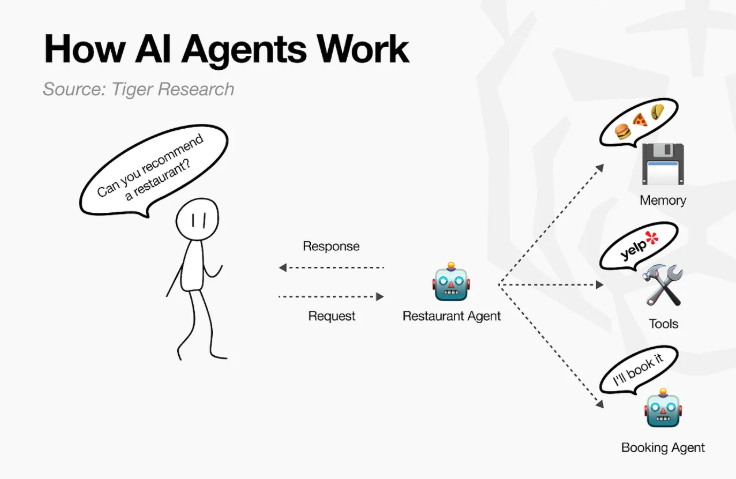
The Collaboration Revolution of AI Agents: How Virtuals Protocol is Unlocking a Trillion-Dollar Economy?
Ever imagined a future where AI isn’t just a ‘passive tool’? For example, when you want to book an allergy-friendly restaurant in Seoul, a ‘restaurant agent’ could automatically contact a ‘translation agent’ to handle the Korean menu, consult a ‘medical agent’ to check allergens, and finalize the reservation—this isn’t science fiction, but the emerging trend of ‘agent collaboration’.
From ‘AI Models’ to ‘AI Agents’: The Industry’s Next Turning Point
Today, the performance of large models like GPT and Claude has stabilized, much like when early humans discovered fire; the key now is ‘how to use the fire well’. AI agents are this turning point: they aren’t passive single-task executors but ‘assistants’ that can proactively understand goals and make independent decisions.
However, individual agents have limitations. Just as you wouldn’t ask a restaurant server to double as a lawyer, agents need ‘specialized division of labor’. But a problem arises: how do agents from different platforms collaborate? How to set prices, sign contracts, and ensure quality? It’s like an international team without a common language—inefficient and chaotic.
Virtuals Protocol: A ‘Collaboration Standard’ for Agents
The ‘Agent Commerce Protocol (ACP)’ launched by Virtuals Protocol solves this by establishing a ‘universal协作 standard’ for global agents, automating collaboration through four stages:
1.* Request Phase : For example, ‘store-opening agent’ Lemo needs a poster and posts a request: ‘Budget $50, design a lemonade shop poster’.
2. Negotiation Phase : ‘Designer agent’ Pixie responds: ‘$40, completed in 2 days’—both agree.
3. Transaction Phase : $40 is deposited into a smart contract, and Pixie starts working.
4. Evaluation Phase *: An ‘evaluation agent’ checks if the poster meets requirements; if approved, payment is auto-settled, and Pixie’s reputation is scored (affecting future trust).
This process enables seamless collaboration between agents from different platforms, much like how Stripe standardized online payments—ACP is activating the entire ‘agent economy’.
Real-World Cases: 24/7 ‘Agent Factories’
The Never-Sleeping On-Chain Hedge Fund
Traditional fund managers need sleep, but agent teams work round-the-clock: ‘Market analysis agents’ track on-chain data in real time, ‘risk management agents’ monitor asset volatility, and ‘investment strategy agents’ auto-adjust positions—all协作 via ACP, no human intervention needed.
Virtual Idol’s Autonomous Content Factory
Take Virtuals’ virtual idol Luna: A ‘meme策划 agent’ captures crypto trends, a ‘music agent’ generates 10-second background tracks, and a ‘video editing agent’ synthesizes short clips—all auto-collaborating to respond to fans in real time, revolutionizing traditional content creation.
The Trillion-Dollar Agent Economy: From $1B to $1T
Currently, ~1 million agents collaborate via ACP, creating $1 billion annually (dubbed ‘Gross Agent Product, GAP’). With AI inference costs plummeting 99.7% and open-source models普及, this figure is projected to hit*$1 trillion by 2035 *.
Challenges remain: privacy protection and cross-chain collaboration need zero-knowledge proofs and other tech to solve. But one thing is clear—when agents can collaborate as efficiently as human teams, a new economic ecosystem is accelerating toward us.
Read More《深度解读Virtuals协议:万亿美元代理经济的崛起》
This content is AI-generated and does not constitute investment advice. Please exercise your own rational judgment.
链上探索《深度解读Virtuals协议:万亿美元代理经济的崛起》
- Startup Commentary”Building LLMs: The Knowledge Graph Foundation Every AI Project Needs”
- Startup Commentary”The 17th Year of Tmall Double 11 and the New Map Rewritten by AI”
- Startup Commentary”How to Prepare Your Data for Artificial Intelligence”
- Startup Commentary”Small and Medium-sized Banks: “Cutting the Tail” in Loan Assistance”
- Startup Commentary”The Six AI Giants on Stage: AGI Is No Longer a “Future” Thing”



